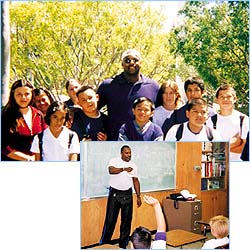
|



oday, severe drug abuse and crime involving youth are almost the ordinary, with newspaper headlines reporting younger and younger ages of those committing the violence and their victims.
In 1975, when National Football League cornerback Reggie Berry retired from professional football, those problems, as for most Americans, seemed largely elsewhere — confined to the worst of the inner cities.
Berry took a job at the Miller Brewing Company selling beer. That might have been the last career move for some players, except Berry is the kind of person who loves to learn. And he soon learned that of all alcoholic beverages, beer sent the most teenagers to the grave. The fact was revelatory, but more so, it inspired him to deter children from alcohol and drug abuse, and to put them on a more meaningful path in life. Berry had to go where the kids are; he changed the course of his life to become a teacher.
After receiving his credentials, Berry’s career as a traditional teacher lasted only a few years. He was a good teacher, but a natural mentor. By 1989 he had gravitated toward a position that allowed him to help youth in a more personal way, especially the ones in the worst socioeconomic band.
The program he was part of helped migrant workers’ children. It was federally funded and operated on a strict mandate concerning who could benefit. It was a positive program, Berry says, but it fell short of the mark when a young girl outside the program’s mandate came to him for help. She confided in Berry that both her father and brother were molesting her. When Berry informed program administrators that he was taking the girl into his class, he was told that he could not. He did anyway.
“Plain Good Coaching”
Berry’s solution for the girl was a temporary one for a bigger problem he was becoming aware of. Government-funded programs tended to limit help for one or another “type” of boy or girl by reason of their funding mandates — and invariably some slipped through the cracks. Berry decided a flexible program with an open-door policy was needed. Not finding a group that met his expectations, in 1989, with personal funds, he founded his own: Goals for Life.
Berry contacted Frank Woschitz, president of the National Football League Players Association, and laid out his strategy for Goals for Life. Berry believed he was not the only pro football player that enjoyed working with children. He also believed that football players are themselves ideal coaches — the kind that really make the difference. Finally, he had limitless belief in the ability of any kid to rise above any barrier that thwarted their goals — providing there was a strategy, and follow through. His “Goals for Life” program would bring all these fundamentals of the gridiron to bear on the lives of troubled teens by coaching them to succeed in school and in life. The program was a privilege and it would demand hard work and dedication from kids who participated, both boys and girls — the kind of determination required of football pros, Berry explained to Woschitz. Woschitz liked the plan and got the National Football League Players Association behind it.
Now in its 13th year, “Goals for Life,” is reaching as many as 10,000 youth a year. Some of the notables who work with children through the program are Elston Ridgle and Leo Gray of the Raiders, Carver Shannon, Lucious Smith and Reggie Doss of the Rams, Rick Ellis of the Sea Hawks and Cephus Weatherspoon of the Saints.
The athletes and others working with the program meet with small groups of students on a regular basis at various schools in Los Angeles. Drawing on their personal experiences in sports and in life, they speak to the youth of the enthusiasm, drive and determination that helped them reach their own goals. They point out that what applies to sports also applies to education. They get each student to clarify goals they want to achieve in life, and instill a sense of dedication and determination about achieving those goals. They demand hard work of the students towards achieving those goals, and give them examples of how to stay the course despite frustrations and setbacks in school or in their personal lives. The athletes spend 24 weeks in a given school, working regularly with at-risk youth.
“The program arms the kids with personal strategies that override all lacks elsewhere, including lack of parental support,” he says. “It enables them to reach their goals.” Berry explains that the first step is always “good old-fashioned listening, no impromptu advice allowed. The point is that the kids need to know that you are tuned in to them. That means their views and ideas as well as their concerns and triumphs must be important to you.”
“That’s How You Win”
The program revolves on the athletes, and Berry relies on their coaching expertise utterly. He explains that a good coach knows that if you want the best out of a boy or a girl, you don’t put down their efforts. “Its just plain good coaching to encourage. Pro football players know how important a good coach is to winning the game,” he says.
By contrast, Berry sees the players’ job being made more difficult for kids whose parents tear them down as fast as the players build them up. He described one young girl who, after extensive work in the program, reverted her grades from “Ds” and “Fs” to “As” and “Bs.” She presented her school report to her mother, who instead of approving of her new-found competence, berated her for thinking she “knew it all” and rebuffed the grades as meaningless. The girl was crushed and could have given up utterly, but Berry says he and his team were there to catch her.
“Of course we know that we can’t be there for the kids indefinitely. As much as we would like to change it, we have a limited time to reach these kids, bolster them, and then we must send them on their way. Many will make it, and that is what we work for,” says Berry. “We have our losses too, but we keep working to improve things.”
The point, says Berry, is to stay in the game. That is the bottom line message to these kids and to the players participating in the program, and not trying to understand what makes the kids tick or makes the parents give up.
“What we are trying to do is build a kid’s confidence high enough so that no matter how hard he is hit, he has enough resilience to try ten more times until he gets what he is after. That’s how you win in football, and that is how you win in life,” he said.
|

|






